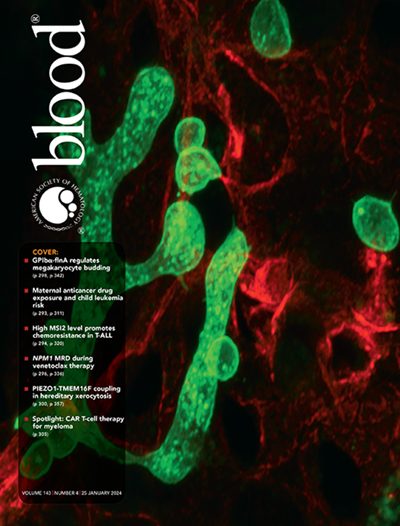一种新的晚期皮肤淋巴瘤预后指数(CLIPI)能够精确地对患者进行风险分层。
IF 23.1
1区 医学
Q1 HEMATOLOGY
引用次数: 0
摘要
晚期蕈样真菌病(MF)和ssamzary综合征(SS)预后较差,总生存期为60年;P <0.001,血清乳酸脱氢酶升高;P =0.005,皮肤大细胞转化;p = 0.006。将这4个独立的危险因素建模到CLIPI中,发现在高危险度vs低危险度p<0.001,高危险度vs中危险度p=0.002,中危险度vs低危险度p=0.010时,有统计学意义的更差的OS。低、中、高风险PROCLIPI患者的5年OS分别为63.3%、44.7%和18.3%。晚期MF/SS患者的5年生存率较低,病程延长与生存率恶化无关。使用CLIPI将患者分为低、中、高风险预后组,通过帮助指导最佳治疗选择,有可能改善患者的预后。CPMS ID 17662 (PROCLIPI), RRK4970,临床试验。政府ID: NCT02848274。本文章由计算机程序翻译,如有差异,请以英文原文为准。
A New Prognostic Index (CLIPI) for Advanced Cutaneous Lymphoma Enables Precise Patient Risk Stratification.
Advanced mycosis fungoides (MF) and Sézary syndrome (SS) have a poor prognosis with overall survival <5 years. Studies have found the current clinical staging (IA-IVB) inadequate for risk stratification. Developing a prognostic index in MF/SS will identify patients with poor outcomes and may allow better management decisions and improved survival.PROCLIPI (Prospective Cutaneous Lymphoma International Prognostic Index) Study was launched in 2015 at 46 international expert MF/SS Centers, prospectively collecting pre-defined datasets in newly diagnosed MF/SS patients to determine a cutaneous lymphoma IPI (CLIPI).552 advanced stage MF/SS patients were recruited. The 5-year overall survival (OS) was IIB=50.0%, IIIA=64.8%, IIIB=43.9%, IVA1=50.8%, IVA2=25.9%, IVB=36.9%. Factors at diagnosis associated with a significantly worse survival were N3 status; p<0.001, age>60yrs; p<0.001, raised serum lactate dehydrogenase; p=0.005 and large-cell transformation in skin; p=0.006. Modelling these 4 independent risk-factors into a CLIPI found there was a statistically significant worse OS in high-versus low-risk p<0.001, high-versus intermediate-risk p=0.002 as well as intermediate-versus low-risk p=0.010. 5 Year OS were 63.3%, 44.7% and 18.3% in the low-, intermediate- and high-risk PROCLIPI cohort respectively.In advanced stage MF/SS there was a low 5-year survival rate and increasing stage was not associated with worsening survival. The use of CLIPI to stratify patients into low, intermediate, and high-risk prognostic groups has the potential to improve patient outcomes by helping guide optimal treatment selection. CPMS ID 17662 (PROCLIPI), RRK4970, ClinicalTrials.Gov ID: NCT02848274.
求助全文
通过发布文献求助,成功后即可免费获取论文全文。
去求助
来源期刊

Blood
医学-血液学
CiteScore
23.60
自引率
3.90%
发文量
955
审稿时长
1 months
期刊介绍:
Blood, the official journal of the American Society of Hematology, published online and in print, provides an international forum for the publication of original articles describing basic laboratory, translational, and clinical investigations in hematology. Primary research articles will be published under the following scientific categories: Clinical Trials and Observations; Gene Therapy; Hematopoiesis and Stem Cells; Immunobiology and Immunotherapy scope; Myeloid Neoplasia; Lymphoid Neoplasia; Phagocytes, Granulocytes and Myelopoiesis; Platelets and Thrombopoiesis; Red Cells, Iron and Erythropoiesis; Thrombosis and Hemostasis; Transfusion Medicine; Transplantation; and Vascular Biology. Papers can be listed under more than one category as appropriate.
 求助内容:
求助内容: 应助结果提醒方式:
应助结果提醒方式:


